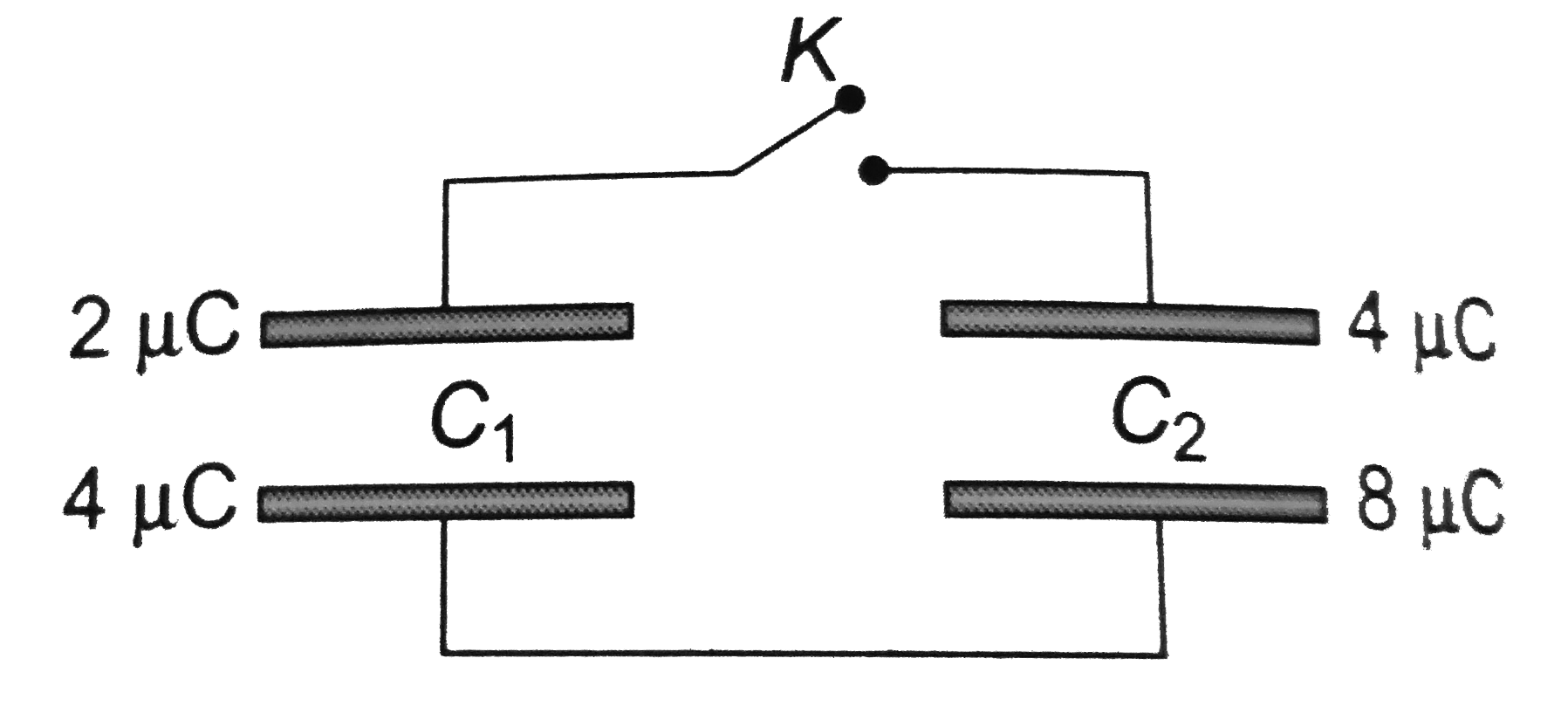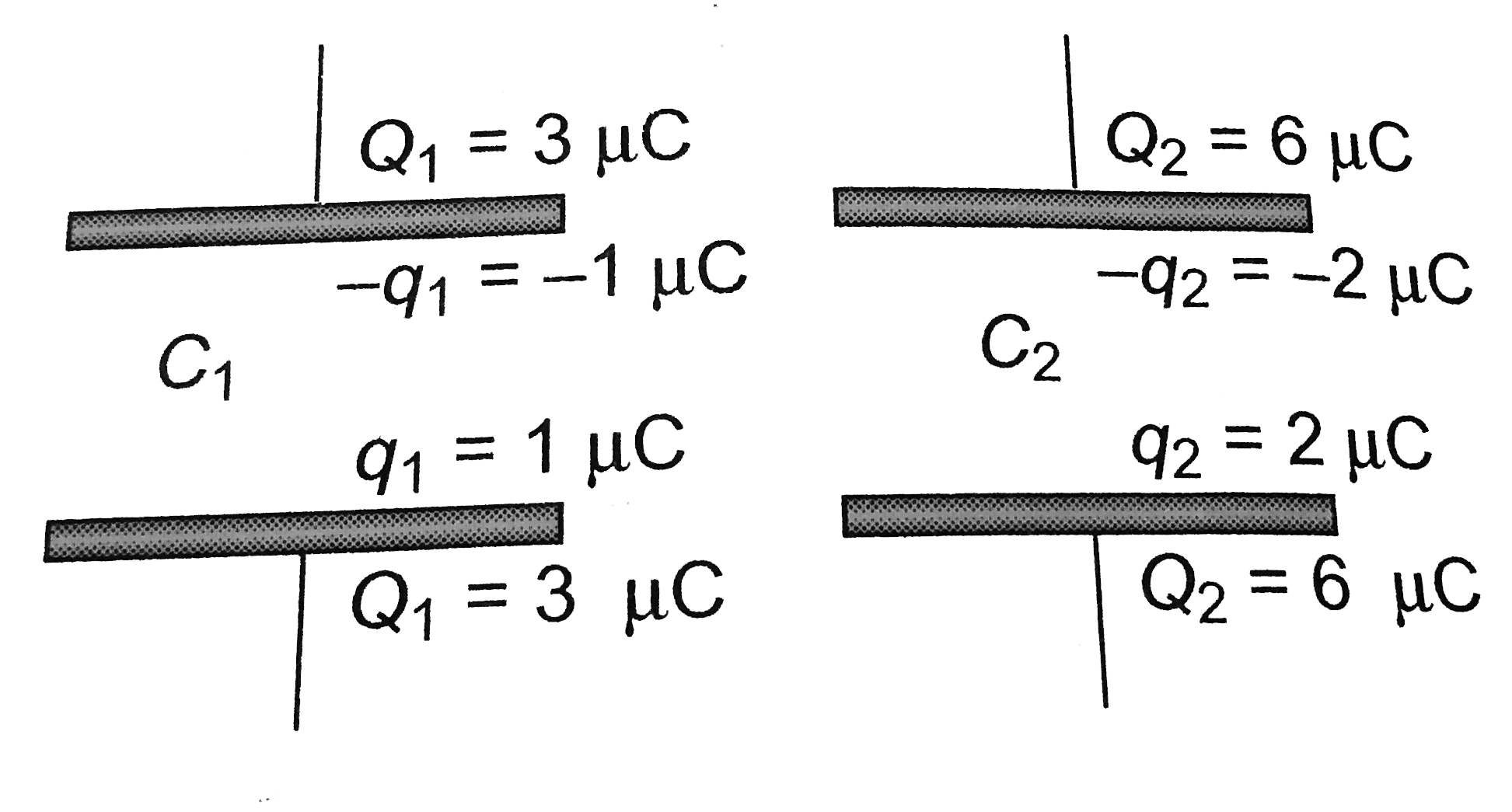Assertion: Charges are given to plates of two plane parallel plate capacitors C1 and C2 (such that C2=2C1) as shown in figure. Then the key K is pressed to complate the circuit. Finally the net charge on upper plate and net charge on lower plate of capacitor C1 is positive.

Reason: In a parallel plate capacitor both plates always carry equal and opposite charge.
A
If both assertion and reason are true and reson is the correct explanation of assertion.
B
If both assertion and reason are true but reason is not the correct explanation of assertion.
C
If assertion is true but reason is false.
D
If assertion and reason both are false.
Video Solution
Text Solution
The correct Answer is:C
In isolated condition the charge distribution on each surface of capacitor C1 and C2 is

The p.d. across first capacitor is q1C1=1μFC1
The p.d across second capacitor is q2C2=2μFC2
Hence potential difference across both the capacitors is same (hence C2=2C1). therefore on connecting both capacitors, charges, charge does not flow from one capacitor to other. Therefore net charge on upper and lower plates of C1 is positive.
Hence Assertion is true and Reason is false.
|
Updated on:21/07/2023
Related Playlists
- BOOK - A2ZCHAPTER - ELECTRIC POTENTIAL & CAPACITANCEEXERCISE - AIPMTNEET Questions38videos
ELECTRIC POTENTIAL & CAPACITANCE
- BOOK - A2ZCHAPTER - ELECTRIC POTENTIAL & CAPACITANCEEXERCISE - AIIMS Questions20videos
ELECTRIC POTENTIAL & CAPACITANCE
- BOOK - A2ZCHAPTER - ELECTRIC POTENTIAL & CAPACITANCEEXERCISE - Problems Based On Mixed Concepts44videos
ELECTRIC POTENTIAL & CAPACITANCE
- BOOK - A2ZCHAPTER - ELECTRIC CHARGE, FIELD & FLUXEXERCISE - Section D - Chapter End Test29videos
ELECTRIC CHARGE, FIELD & FLUX
- BOOK - A2ZCHAPTER - ELECTROMAGNETIC INDUCTIONEXERCISE - Section D - Chapter End Test30videos
ELECTROMAGNETIC INDUCTION
Knowledge Check
- Question 1 - Select One
A parallel plate capacitor is charged. If the plates are pulled apart
Athe potential difference increasesBthe capacitance increasesCthe total charge increasesDthe charge and the potential difference remain the same - Question 1 - Select One
If the plates of a parallel plate capacitor are not equal in area then quantity of charge
AOn the plates will be same but nature of charge will differBOn the plates as will as nature of charge will be differentCOn the plates will be different but nature of charge will be sameDAs well as nature of charge will be same - Question 1 - Select One
A parallel plate capacitor C has a charge Q. The actual charges on its plates are
AQ,QBQ/2, Q/2CQ,-QDQ/2. - Q/2 - Question 1 - Select One
A positive charge q is given to each plate of a parallel plate air capacitor having plate area A and plate separation d, then
Asince both the plates are identially charged, therefore, capacitance become equal to zeroBenergy stored in the space between the capacitor plates is equal to q2ε0A2Cno charge appears on inner surface of the platesDpotential difference between the plates is equal to 2qdε0A - Question 1 - Select One or More
The plates of a parallel plate capacitor are, not exactly parallel. The surface charge density therefore :
AIs higher at the closer endBThe surface charge densitywill not be uniformCEach plate will have the same potential at each pointDThe electric field is smallest where the plates are closest - Question 1 - Select One or More
The plates of a parallel plate capacitor are, not exactly parallel. The surface charge density therefore :
Ahigher at the closer endBthe surface charge density will not be uniformCeach plate will have the same potential at each point.Dthe electric field is smallest where the plates are closest. - Question 1 - Select One
The electrostatic force between the metal plate of an isolated parallel plate capacitro C having charge Q and area A, is
AProportional to the square root of the distance the plates.BLinearly proportional to the distance between theCIndepdent of the distance between the platesDInversely proportional to the distance between the plates - Question 1 - Select One
One plate of parallel plate capacitor is smaller than the other, the charge on the smaller plate will be.
Aless than otherBmore than otherCequal to otherDwill depend upon the medium between them - Question 1 - Select One or More
In an isolated parallel plate capacitor of capacitance C the four surfaces have charges Q1,Q2,Q3 and Q4 as shown in the figure. The potential difference between the plates is :
 AQ1+Q2CB∣∣∣Q2C∣∣∣C∣∣∣Q3C∣∣∣D1C[(Q1+Q2)−(Q3−Q4)]
AQ1+Q2CB∣∣∣Q2C∣∣∣C∣∣∣Q3C∣∣∣D1C[(Q1+Q2)−(Q3−Q4)]

